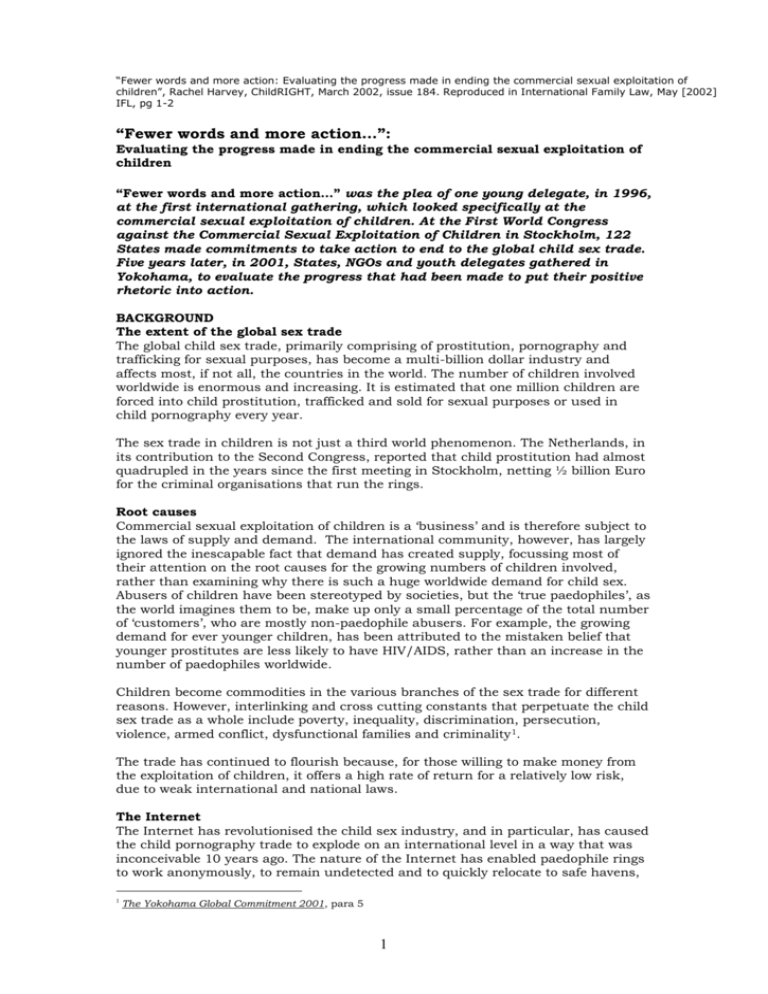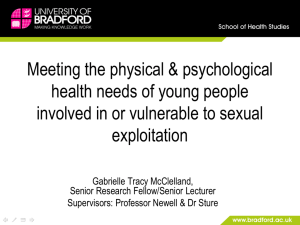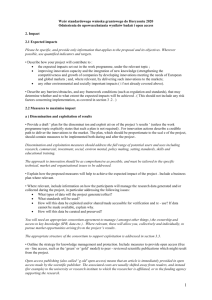
“Fewer words and more action: Evaluating the progress made in ending the commercial sexual exploitation of
children”, Rachel Harvey, ChildRIGHT, March 2002, issue 184. Reproduced in International Family Law, May [2002]
IFL, pg 1-2
“Fewer words and more action…”:
Evaluating the progress made in ending the commercial sexual exploitation of
children
“Fewer words and more action…” was the plea of one young delegate, in 1996,
at the first international gathering, which looked specifically at the
commercial sexual exploitation of children. At the First World Congress
against the Commercial Sexual Exploitation of Children in Stockholm, 122
States made commitments to take action to end to the global child sex trade.
Five years later, in 2001, States, NGOs and youth delegates gathered in
Yokohama, to evaluate the progress that had been made to put their positive
rhetoric into action.
BACKGROUND
The extent of the global sex trade
The global child sex trade, primarily comprising of prostitution, pornography and
trafficking for sexual purposes, has become a multi-billion dollar industry and
affects most, if not all, the countries in the world. The number of children involved
worldwide is enormous and increasing. It is estimated that one million children are
forced into child prostitution, trafficked and sold for sexual purposes or used in
child pornography every year.
The sex trade in children is not just a third world phenomenon. The Netherlands, in
its contribution to the Second Congress, reported that child prostitution had almost
quadrupled in the years since the first meeting in Stockholm, netting ½ billion Euro
for the criminal organisations that run the rings.
Root causes
Commercial sexual exploitation of children is a ‘business’ and is therefore subject to
the laws of supply and demand. The international community, however, has largely
ignored the inescapable fact that demand has created supply, focussing most of
their attention on the root causes for the growing numbers of children involved,
rather than examining why there is such a huge worldwide demand for child sex.
Abusers of children have been stereotyped by societies, but the ‘true paedophiles’, as
the world imagines them to be, make up only a small percentage of the total number
of ‘customers’, who are mostly non-paedophile abusers. For example, the growing
demand for ever younger children, has been attributed to the mistaken belief that
younger prostitutes are less likely to have HIV/AIDS, rather than an increase in the
number of paedophiles worldwide.
Children become commodities in the various branches of the sex trade for different
reasons. However, interlinking and cross cutting constants that perpetuate the child
sex trade as a whole include poverty, inequality, discrimination, persecution,
violence, armed conflict, dysfunctional families and criminality 1.
The trade has continued to flourish because, for those willing to make money from
the exploitation of children, it offers a high rate of return for a relatively low risk,
due to weak international and national laws.
The Internet
The Internet has revolutionised the child sex industry, and in particular, has caused
the child pornography trade to explode on an international level in a way that was
inconceivable 10 years ago. The nature of the Internet has enabled paedophile rings
to work anonymously, to remain undetected and to quickly relocate to safe havens,
1
The Yokohama Global Commitment 2001, para 5
1
where gaps in legislation and regulations allow them to continue to supply and
exchange child pornography with impunity. While Japan was the leading country in
child pornography when the First Congress was held in 1996, the introduction of
tough national legislation has caused the trade to shift to countries with weaker
laws such as Russia, Cyprus, Taiwan and the United States - Interpol currently cites
the US as the biggest source of websites offering child pornography.
Governments and international organisations, such as Interpol, have found it to be
a Herculaneum task, to keep up with the technological advances in the industry.
Currently, there are estimated to be only 20 countries in the world that actually
have the technology and personnel required to fight this crime.
Sexual exploitation of children by aid workers
It is well documented that during armed conflict, children are vulnerable to being
trafficked to other countries in order to be used as commodities in the sex trade,
and to being forcibly recruited into the armed groups to serve as ‘wives’ (sexual
slaves) for the combatants. However, a report released last month by United Nations
High Commissioner for Human Rights (UNHCR) and Save the Children 2 highlights
the vulnerability of children to sexual exploitation by the very people who have been
recruited to assist the war torn communities.
The report details disturbing evidence that personnel employed by a range of
agencies, responsible for the care and protection of refugees and internally displaced
persons, are using their position to sexually exploit children. It is asserted that
humanitarian aid workers use food and aid, which is intended to benefit the
community, as a bargaining tool to obtain sex from girls, primarily in the 13-18
category. Both international and local staff have been implicated, including workers
of respected and established agencies, such as UNHCR. Poverty, the lack of other
opportunities, insufficient supplies and the bad management of aid delivery have
been cited as the underlying causes for this problem. It seems that a conspiracy of
silence among the aid workers has contributed to the perpetuation of this practice.
The report also draws attention to the sexual exploitation of children by
peacekeepers, who are said to be the highest paying customers for sex with children.
It is known that where peacekeepers have been sent, the number of children
involved in the local child sex industry has risen to cater for the increased demand.
International Developments
Despite increased international attention regarding the issue in the early ‘90s, when
the First Congress met in 1996, there was an incredibly limited international legal
framework in existence to protect children from commercial sexual exploitation. The
only instrument that specifically protected children was the Convention on the
Rights of the Child (CRC), which came into force in 1990. Under the CRC, States are
obliged to take all appropriate national and international measures to protect
children from both sexual abuse and commercial sexual exploitation (Article 34) and
from being sold or trafficked for any purpose or in any form (Article 35). Also in
1990, the UN Commission on Human Rights created the post of Special Rapporteur
on the sale of children, child prostitution and child pornography, who is mandated
to investigate and monitor the involvement of children in the child sex trade
worldwide, and to recommend measures aimed at ending these practices at a
national, regional and international level.
The First Congress brought States together in order to develop strategies to combat
the commercial sexual exploitation of children. At the conclusion of the First
Congress, all 122 States attending the Congress adopted the Stockholm Declaration
“Note for Implementing and Operational Partners on Sexual Violence and Exploitation: The Experience of
Refugee Children in Guinea, Liberia and Sierra Leone based on Initial Findings and Recommendations from
Assessment Mission, 22 October – 30 November 2001” , UNHCR and Save the Children-UK (February
2002)
2
2
and the Agenda for Action, which had been drafted to embody these strategies. By
doing so, States committed to giving high political and resource priority to the
problem, to criminalizing all forms of sexual exploitation, and to developing laws to
combat and prevent the exploitation of children. States also pledged to draw up
national plans of action to reduce the number of children who are sexually
exploited, by the year 2000.3
Five years after these first commitments were made, a Second Congress was held in
Yokohama to review the progress made by States and to devise further methods to
protect children from sexual exploitation.
DEVELOPMENTS SINCE STOCKHOLM
International legislation
Since the first meeting in Stockholm, the international community has focused a lot
of attention on the issue of child sexual exploitation and a number of important
documents have been drafted:
In 1999, the International Labour Organisation adopted the ILO Convention
182 on the Worst Forms of Child Labour. The sale and trafficking of
children, and the use procuring or offering of a child for prostitution, for the
production of pornography or for pornographic performances, are included in
the list of the worst forms of child labour. States Parties are obliged to design
and implement programmes of action to end these practices.
The following year, the Optional Protocol to the Convention on the Rights
of the Child on the sale of children, child prostitution and child
pornography was adopted. The Optional Protocol came into force on 18th
January 2002, exactly one month after the Second Congress. While the
Optional Protocol certainly raised awareness of the urgent need to take
action, many commentators voiced disappointed that it merely reiterated
existing instruments. Further, criticisms were made that not only did the
Optional Protocol fail to advance the protection for children, but that it
actually set a lower standard than the CRC. For example, States are obliged
only to take all feasible measures rather than all appropriate measures to end
commercial sexual exploitation.
The United Nations Convention against Transnational Organised Crime
and its supplementary Protocol to Prevent, Suppress and Punish
Trafficking in Persons, Especially Women and Children (2000) have
recently been adopted, adding to the framework of international legislation
that addresses child commercial sexual exploitation. The Protocol contains
the first international agreement on the definition of trafficking and also,
significantly, addresses the demand side of exploitation that leads to
trafficking.
The Council of Europe Convention on Cybercrime (2001), is the first
international instrument to tackle crimes on the Internet and the first to
specifically oblige States to criminalize child pornography on the web (Article
9). Although the Convention is a regional instrument, States that are neither
members of the Council of Europe nor were involved in the elaboration of the
instrument, can be invited to accede.
State action
At the Second Congress, in 2001, it was found that the grand commitments made in
1996 had not translated into reality. Five years after the First Congress, the
situation for children had actually worsened and new forms of exploitation had
emerged. While international legislation had been developed, there was
disappointment at the speed of implementation of laws and programmes to combat
the trade and at the general lack of State action. Indeed, only 34 countries had met
the 2000 deadline for the submission of national plans of action.
It must be noted that neither the Stockholm Declaration nor the Agenda for Action are legally binding
instruments
3
3
However, there have been some positive results since Stockholm. The First Congress
succeeded in raising awareness of the issues and placing the commercial sexual
exploitation of children high up on the international child rights agenda. At a
national level, while national plans of action have not been forthcoming, the
Congress noted that many States have enacted national legislation, criminalizing the
trade. However, as States have not heeded calls to develop data collection methods,
the impact of such reforms is difficult to assess.
Progress has been made in combating child sex tourism. 21 countries have changed
their national laws to allow abusers to be prosecuted at home for crimes that they
commit against children abroad. Although prosecutions under extraterritorial law
have been limited, the massive publicity that has been given to these cases may well
have a deterrent effect on child sex tourists in the future. 4
Second Congress – the way forward
The Second Congress was viewed as highly successful, attracting 138 States, which
indicated the growing State interest in this issue, and over 3000 delegates including
90 official youth delegates, who fully participated in proceedings, unlike in 1996.
Delegates expressed a strong will to reiterate and build on past commitments to end
the child sex trade. One of the most important messages to come out of the
Congress was that the demand side of commercial child exploitation must be
urgently investigated and tackled.
At the conclusion of the Second Congress, the Yokohama Global Commitment 2001
was adopted, which reinforced the Stockholm Declaration and called on
Governments and NGOs to renew their fight against the commercial sexual
exploitation of children. The Global Commitment specifically includes calls for:
fast ratification of the relevant international instruments;
action to tackle root causes including improved educational access for
children, especially for girls, anti-poverty programmes, social support
measures, and public awareness raising;
action to criminalize the commercial sexual exploitation of children in all its
forms, while not criminalizing or penalizing the child victims;
training for law enforcement officers;
increased international co-operation;
increased resources to be made available by States; and
the increased participation of young people in the fight to end the trade.
Conclusion
The youth delegates, in their closing statement at the Second Congress, asked,
“When shall we have a … world free from commercial sexual exploitation?”. Since
1996, developments have been made in the fight against commercial sexual
exploitation of children. In particular, there now exists an international legal
framework backed up by a number of regional instruments to tackle the child sex
trade. The Yokohama Global Commitment 2001 further provides States with a
strategic plan of action.
If States acted upon their legal obligations and fulfilled the commitments made at
the Congresses, then significant progress could be made in ending the commercial
sexual exploitation of children. However, as with all children’s rights, obtaining
commitments from States is the easy part. Actually getting States to follow up their
words with action is notoriously difficult. Until States invest the necessary level of
resources, children will continue to be sexually exploited for profit, and for the
“Second World Congress – Bridging the gap between reality on the ground and international action”,
Hélène Sackstein, Coordinator of the Focal Point on Sexual Exploitation of Children, 2001
4
4
children caught up in the sex trade, State commitments will be worth little more
than the paper they are written on.
5







